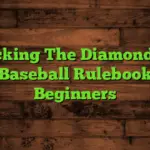Learning how to bunt effectively can significantly impact your baseball game, regardless of your skill level. This comprehensive guide will walk you through every aspect of bunting, from the basic techniques to advanced strategies. You’ll learn the different types of bunts, the proper stance and grip, and how to execute each bunt successfully. Whether you’re a beginner just starting out or a seasoned player looking to refine your skills, this guide has something for everyone. We’ll also cover when and why you should bunt, exploring both the advantages and disadvantages of this crucial baseball skill. By the end, you’ll be ready to confidently put the ball in play with a well-executed bunt.
Bunting in baseball is a batting technique where the hitter attempts to make contact with the pitched ball softly, typically
using the bat’s handle to guide the ball along the ground toward the infield. It’s a strategic maneuver used to advance runners, especially in situations with runners on base.
Why is Bunting Important?
Bunting is a critical skill in baseball because it can change the momentum of the game. It allows a batter to sacrifice their at-bat to advance runners and create scoring opportunities. This is particularly valuable in close games or when the team needs to manufacture runs.
The Different Types of Bunts
There are several types of bunts, each with its own purpose and technique:
- Safety Squeeze: A bunt attempt to score a runner from third base with less than two outs.
- Suicide Squeeze: A risky bunt where the runner on third attempts to score regardless of whether the bunt is successful. This is typically used when the game is on the line.
- Drag Bunt: A bunt aimed to roll the ball slowly along the ground near the first base line.
- Push Bunt: A bunt with a softer contact, designed to place the ball near the pitcher’s mound, making it harder to field quickly.
- Square Bunt: Similar to the push bunt but slightly less directed towards the mound; it’s a more neutral approach.
The Proper Bunting Stance and Grip
Finding Your Ideal Stance
A good bunting stance is crucial. It should be similar to your regular batting stance, but slightly closer to the plate. Your weight should be balanced, allowing you to react quickly to the pitch. Practice adjusting your stance until you find a comfortable and stable position.
Choosing the Right Grip
The grip for bunting is different from the typical batting grip. Instead of a firm grip, hold the bat closer to the handle with a relaxed grip, almost as if you’re gently holding a chopstick. This allows for better control and more delicate contact with the ball.
Executing Different Bunting Techniques
Mastering the Drag Bunt
The drag bunt requires a short, controlled swing. The goal is to softly guide the ball along the first baseline, causing it to roll slowly towards the first baseman. Practice keeping the bat head level and making contact underneath the ball.
Perfecting the Push Bunt
A push bunt focuses on directing the ball towards the pitcher’s mound. This requires a slightly upward movement of the bat to lift the ball off the ground enough for it to have some distance while still being a soft contact.
Advanced Bunting Strategies
Bunting with Runners on Base
The presence of runners significantly impacts bunting strategy. With runners on first and second, for example, the objective often shifts from simply advancing runners to scoring runs. The type of bunt will depend on the outs, the speed of the runners, and the defensive positioning.
Counteracting Defensive Strategies
Defenses will adjust to your bunting style. Be prepared for different defensive shifts that try to counter your bunts. Adapting to these defensive adjustments will require practicing different types of bunts and being aware of where the fielders are positioned.
Reading Pitch Location and Type
Reading the pitch’s location and type is extremely important for successful bunting. A high and inside pitch will make a bunt more challenging to control, whereas a low and outside pitch could create a chance for a slower bunt.
The Importance of Practice and Repetition
Practice Drills for Bunting
Consistent practice is key to mastering bunting. Set up drills focusing on specific types of bunts, such as drag bunts or push bunts. Use a pitching machine or have a teammate throw pitches at various speeds and locations to simulate game-like situations.
Working on Specific Weaknesses
Identify and address your weaknesses during practice. Are you struggling with the push bunt? Spend extra time practicing that specific technique. Consistent practice will help build your confidence and improve your bunting abilities.
When and Why to Bunt
Situational Awareness in Bunting
Situational awareness is crucial. Consider the score, the number of outs, the base runners, and the opposing team’s defensive alignment before deciding to bunt.
Choosing the Right Time to Bunt
Generally, bunting is a better choice when runners are on base and when there is a low risk of striking out.
Bunting vs. Swinging: Understanding the Trade-offs
Analyzing the Pros and Cons of Bunting
While bunting advances runners, it sacrifices a potential hit. It’s a calculated risk. You might give up an out, but you also might gain an advantage if the bunt is successful.
When Swinging is a Better Option
In situations where runners are not on base, or the score allows for more aggressive play, swinging away is usually the preferred choice.
Common Bunting Mistakes
Identifying and Correcting Errors
Common errors include gripping the bat too tightly, failing to adjust to the pitch, poor contact, and poor footwork. Video recording can help you pinpoint these mistakes and adjust your technique.
Advanced Techniques and Variations
Utilizing Deception in Bunting
Mastering deception will help you confuse the defense. By occasionally mixing in swing attempts, or varying the type of bunt you use, you can prevent the defense from anticipating your next move.
Bunting against Different Defensive Setups
Different defensive alignments require different bunting approaches. Learn how to adjust your technique based on the fielders’ positions to maximize your chances of a successful bunt.
The Mental Game of Bunting
Maintaining Confidence and Focus
Confidence and focus are crucial for successful bunting. Visualize a successful bunt before you step up to the plate, concentrate on the pitch, and trust your technique.
Handling Pressure Situations
In high-pressure situations, maintaining calm and focus is essential. Practice bunting in pressure scenarios during practice to improve your ability to perform under pressure.
Frequently Asked Questions
What are the most common bunting mistakes beginners make?
Beginners often grip the bat too tightly, resulting in poor contact. They also frequently fail to properly adjust their stance, leading to inconsistent contact and direction. Focusing on a relaxed grip and a balanced stance is essential for beginners.
How can I improve my bunting speed?
Improved speed comes from practicing quick movements. Work on your footwork, ensuring you are transferring your weight effectively, and practice a quick, controlled swing. Using a pitching machine can help improve your timing and reaction speed.
Is bunting more effective against certain types of pitches?
Slower pitches generally make bunting easier, as they provide more time to react and execute the bunt. Faster pitches require quicker reflexes and precise timing.
How do I choose the right type of bunt for a given situation?
The choice depends on several factors: the number of outs, the base runners’ speed, the score, and the defensive alignment. Consider a safety squeeze with a runner on third and less than two outs. If it’s a close game, consider a suicide squeeze, but it is a riskier play.
How important is practicing bunting?
Practice is absolutely essential for mastering bunting. It develops muscle memory, improves timing, and helps build confidence. Regular practice is crucial to become proficient in different bunt types.
Final Thoughts
Mastering the art of bunting in baseball requires dedication and consistent practice. By understanding the different techniques, adapting to various situations, and honing your skills through repetition, you can significantly improve your contribution to the team. Remember that bunting is a strategic tool, not just a random act. Proper execution requires a combination of technical skill, mental focus, and astute situational awareness. By incorporating the tips and techniques outlined in this guide, you’ll be well on your way to becoming a proficient bunter, enhancing your overall baseball prowess. So, grab your bat, find a field, and start practicing! With enough dedication, you’ll transform your bunting ability from an occasional attempt into a reliable, game-changing asset.





